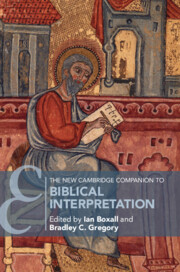Book contents
- The New Cambridge Companion to Biblical Interpretation
- Cambridge Companions to Religion
- The New Cambridge Companion to Biblical Interpretation
- Copyright page
- Contents
- Figures
- Contributors
- Acknowledgments
- Abbreviations
- Introduction
- Part I Methods
- 1 A Historical, Critical Retrospective on Historical Criticism
- 2 Historical Criticism
- 3 Philosophical Hermeneutics
- 4 Literary Criticism
- 5 Rhetorical Criticism
- 6 Intertextuality
- 7 Social-Scientific Criticism
- Part II Frameworks/Stances
- Part III Reception
- Scripture Index
- General Index
- Cambridge Companions to Religion
- References
5 - Rhetorical Criticism
from Part I - Methods
Published online by Cambridge University Press: 15 October 2022
- The New Cambridge Companion to Biblical Interpretation
- Cambridge Companions to Religion
- The New Cambridge Companion to Biblical Interpretation
- Copyright page
- Contents
- Figures
- Contributors
- Acknowledgments
- Abbreviations
- Introduction
- Part I Methods
- 1 A Historical, Critical Retrospective on Historical Criticism
- 2 Historical Criticism
- 3 Philosophical Hermeneutics
- 4 Literary Criticism
- 5 Rhetorical Criticism
- 6 Intertextuality
- 7 Social-Scientific Criticism
- Part II Frameworks/Stances
- Part III Reception
- Scripture Index
- General Index
- Cambridge Companions to Religion
- References
Summary
Rather than regard texts primarily as repositories of ideas or as resources for historical reconstruction, rhetorical interpretation reads them as dynamic interventions in the lives of social groups. This chapter uses the epistle to Philemon as a case study.
- Type
- Chapter
- Information
- The New Cambridge Companion to Biblical Interpretation , pp. 91 - 109Publisher: Cambridge University PressPrint publication year: 2022

